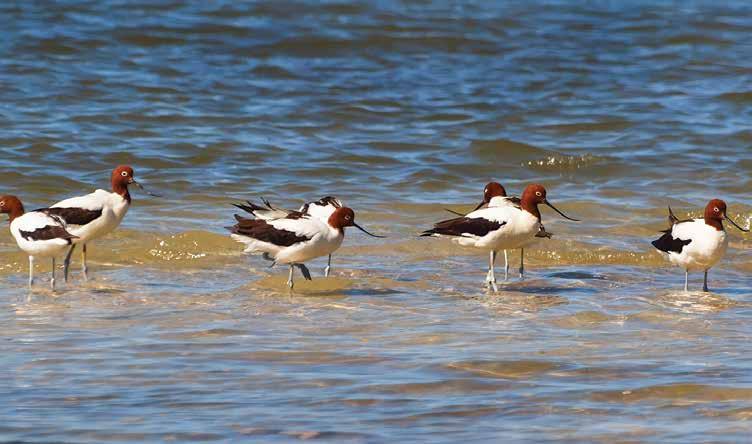
2 minute read
Nature
By: Marj Webber
Red-necked Avocet –
Advertisement
Recurvirostra novaehollandiae
IN MY LIFETIME (86 YEARS) I HAVE SIGHTED RED-NECKED AVOCETS ONLY 3 TIMES – ONCE ON BRIBIE ISLAND AT MISSION POINT ROOSTING IN SHALLOW WATER, ONCE AT TOORBUL AND ONCE AT THE PORT OF BRISBANE. IT IS ALWAYS A THRILL TO CATCH SIGHT OF THE ELUSIVE AVOCETS AS THEY ARE SUCH STRIKING AND UNUSUAL BIRDS. REGRETFULLY THEY DO NOT OFTEN VISIT OUR SHORES ON BRIBIE ISLAND. THERE ARE FOUR SPECIES OF AVOCETS IN THE WORLD, BUT ONLY ONE IS ENDEMIC TO AUSTRALIA.
Red-necked Avocets are like Black-winged Stilts but have long, black, and upturned bills (83-107mm), rusty red necks and white eye-rings. The rest of their bodies and wings are black and white with long greyish legs. They are about 40-46 cm from head to tail and weigh 270-390g. When feeding or roosting they are usually silent but will call if disturbed, and when flying their call is like that of a barking dog. Their feet are webbed which enables them to swim. Both males and females are similar, but males have a more upturned bill. If conditions are suitable, they are sedentary, but with our climate of droughts and floods, they are normally quite nomadic chasing locations that suit their needs. They have been recorded in most parts of Australia, both on our coastlines and inland and on both salt and freshwater wetlands, with a preference for brackish water, and paying only rare, accidental visits to Cape York and Tasmania. Food is obtained by moving their long, upturned bills from side to side in shallow water, or swimming into deeper water and tip tilting or upending to find food beneath the surface, probably relying on touch to recognize their prey. Avocets are sociable birds and often congregate in large flocks throughout most of the inland, often in the company of stilts on saltwater lakes that are drying up. Here they feast on brine shrimp as the water recedes. Other foods consist of small fish, insects, crustaceans, aquatic vegetation, seeds, and worms. Breeding takes place sometimes in single pairs or in scattered colonies mainly in the southwestern interior between August-December, or after rain. Courting rituals involve bill crossing and bowing by the males in shallow water. Nests of aquatic vegetation and mud are built, normally around small bushes on marshy ground, and often near water that is drying up. 3-5 creamy olive eggs are laid and often arranged in circles with the pointy end facing the middle. Both parents incubate the eggs for 3-4 weeks strenuously swooping upon likely predators. One clutch is produced each season. The Red-necked Avocet was featured on the Australian 13cent postage stamp in 1966. There are few predators, but feral cats and foxes will take chicks if given the opportunity. If nests and chicks are being threatened parents will often pretend to have a broken wing and try to distract predators by leading them away from their nests. Conservation is secure in all states except Tasmania where they are not present. The photograph was taken at Toorbul on 27.08.2013.









